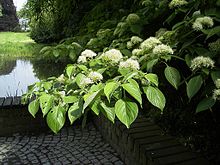Pagoda dogwood
| Pagoda dogwood | ||||||||||||
|---|---|---|---|---|---|---|---|---|---|---|---|---|

Typical growth habit of a flowering pagoda dogwood ( Cornus controversa ) |
||||||||||||
| Systematics | ||||||||||||
|
||||||||||||
| Scientific name | ||||||||||||
| Cornus controversa | ||||||||||||
| Hemsl. ex Prain |
The pagoda dogwood ( Cornus controversa ), also known as the giant dogwood , is a species of the dogwood genus ( Cornus ) within the dogwood family (Cornaceae). It comes from East Asia and is used as an ornamental plant. Occasionally the alternate dogwood ( Cornus alternifolia ) is also called the pagoda dogwood.
description
The pagoda dogwood is a shrub or tree that can grow to heights of 10 to 15 meters. The treetop is very noticeable as the beasting grows in layers in horizontal positions. The bark is gray and smooth; With increasing age, fine cracks form until the bark breaks open in broad ridges. The young twigs are dark red.
The alternate leaves are dark green on the top and lighter on the underside, ovoid and briefly pointed at the otherwise blunt end of the leaf. The leaves are about 9 to 13 inches long and 7 inches wide; they each have six to nine distinct, almost parallel leaf veins . The leaf stalks are about 4 inches long. The leaves turn yellow to crimson in autumn before falling off.
The flowering period begins in May, plants in Central Europe bloom from June to July. The white hermaphrodite flowers are about 1 centimeter tall; they stand in five to 15 centimeters large, umbel-like panicles on a thick, hairy stem. Unlike many other dogwood species, the inflorescences are not surrounded by showy bracts . The flowers are pollinated by insects. The seeds ripen in Central Europe from September to October, they are round, about the size of a pea and bluish-black in color.
The number of chromosomes is 2n = 20.
Occurrence
The homeland of the pagoda dogwood stretches from the eastern Himalayas ( Nepal , northern India ) via China to Korea and Japan .
It is mostly found in deciduous forests and manages to grow even in shady conditions.
Systematics
The first description of was in 1909 by William Botting Hemsley in David Prain : Botanical Magazine , p. 135, sub panel 8261. Synonyms for Cornus controversa Hemsl. ex Prain are: Bothrocaryum controversum (Hemsl.) Pojark. , Cornus brachypoda Miq. , Cornus controversa var. Angustifolia Wangerin , Cornus obovata Thunb. , Cornus sanguinea Thunb. , Swida controversa (Hemsl.) Soják. .
use
The leaves are used in folk medicine for pain relief, among other things. Oil is extracted from the seeds.
Ornamental plant
In Central Europe, it is sometimes found as an ornamental wood in large parks and botanical gardens. It prefers partially shaded locations with a moist, cool and lime-free soil .
Some cultivated forms are:
- 'Candle Light': leaves yellow when they shoot, later green
- 'Marginata': leaves with a narrow white and pink edge
- 'Pagoda': Regular growth, branches spread out
- 'Variegata': This variety, which is often offered, becomes about five meters high, sometimes up to ten meters. The leaves are narrower than the type, four centimeters tall and have a wide creamy white border.
swell
- ↑ a b c Cornus controversa in the Flora of China .
- ↑ Flowering time in the Missouri Botanical Garden
- ↑ Cornus controversa at Tropicos.org. In: IPCN Chromosome Reports . Missouri Botanical Garden, St. Louis
- ↑ Cornus controversa at Tropicos.org. Missouri Botanical Garden, St. Louis
Web links
- Thomas Meyer: Data sheet with identification key and photos at Flora-de: Flora von Deutschland (old name of the website: Flowers in Swabia )
- Entry at GRIN - Taxonomy for Plants .
- Brief description at Plants for a Future . (English)
- Photos by C. controversa by Jenny Qiuyun Xiang, North Carolina State University.
